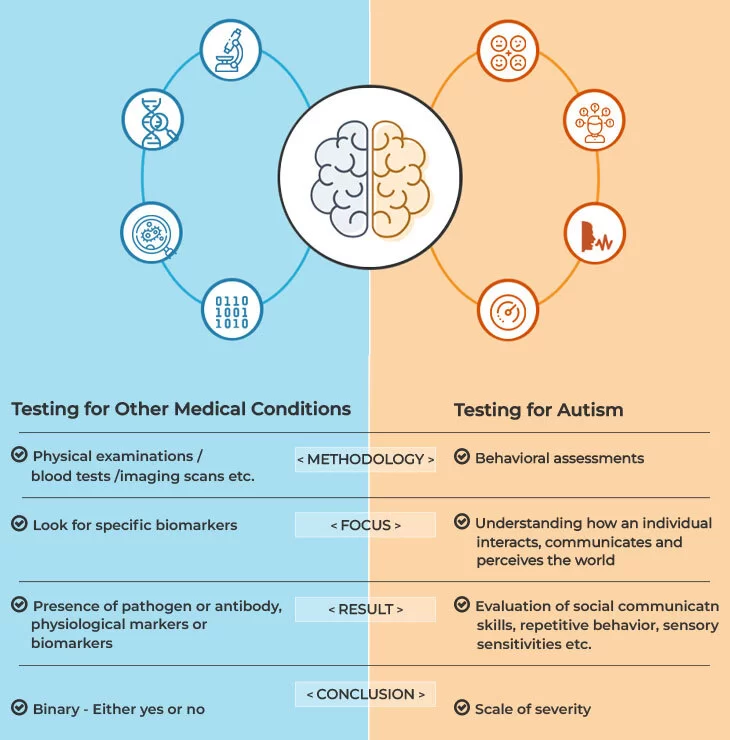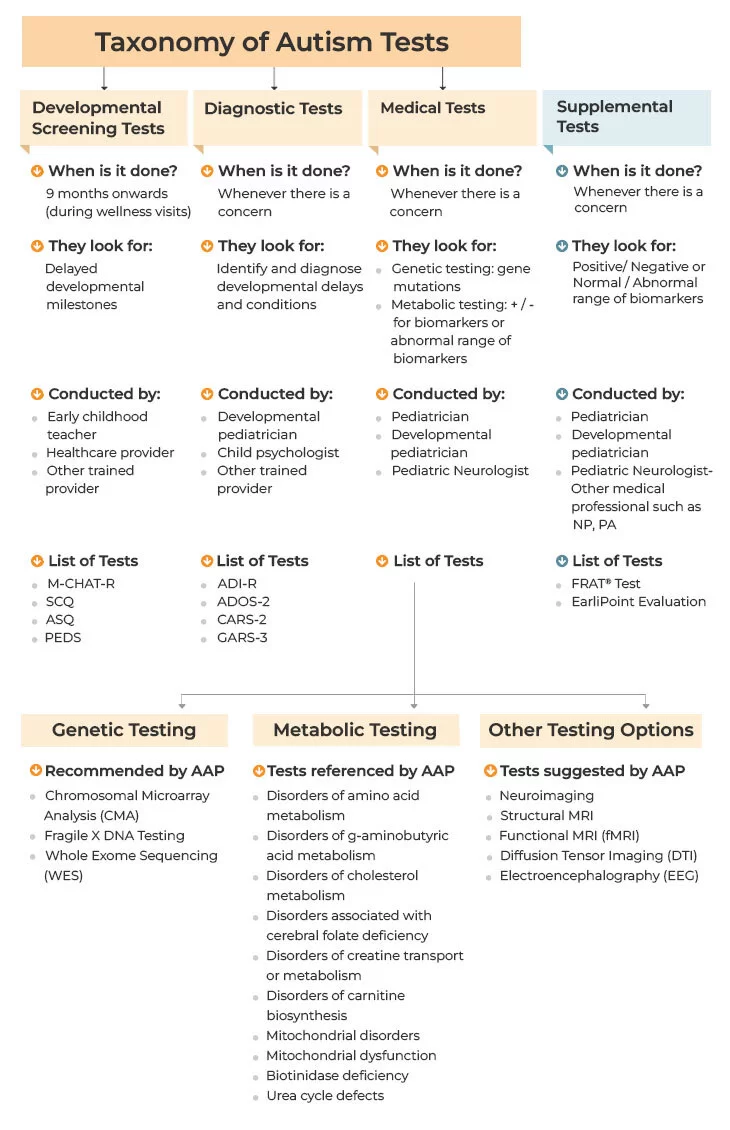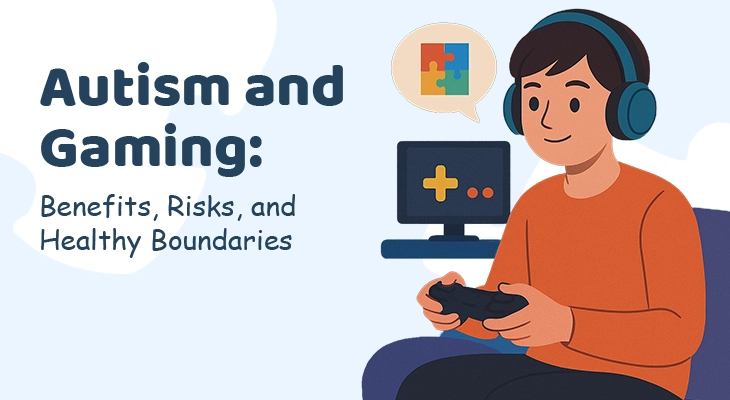Table of Content
- Introduction
- What distinguishes autism tests from tests for other medical conditions?
- Understanding autism monitoring, screening and testing cycle
- Developmental screening tests for autism
- Diagnostic tests for autism
- Medical tests for autism
- Supplemental tests for autism
- Conclusion
- Did You Know About Folate Receptor Autoantibodies (FRAAs) and Brain Development?
- References
Introduction
Welcome to your guide to understanding autism tests. If you suspect that someone you care about may be on the autism spectrum, it’s important to explore the possibility further. In this blog, we will dive into the various tests used to assess autism, enabling you to navigate the diagnostic process with greater clarity and insight. By the end, you’ll have a better understanding of the assessments commonly employed to identify autism and how they contribute to a comprehensive evaluation. So, let’s begin your journey of unraveling the tests for autism and gaining a deeper understanding of this complex condition.
What distinguishes autism tests from tests for other medical conditions?
Autism is not a disease in the traditional sense because it is not caused by pathogens or abnormal cell growth. Instead, it is a neurodevelopmental disorder characterized by differences in brain structure and function. The exact cause of autism is not fully understood, but it is believed to involve a combination of genetic and environmental factors.
Therefore, when it comes to autism, the diagnostic processes employed differ significantly from those used for other medical conditions. Unlike many medical conditions that can be diagnosed through physical examinations, blood tests, or imaging scans, autism is a neurodevelopmental disorder that primarily relies on behavioral assessments and observations.

Download Download & share this infograph in your network [Free Download]

Decoding autism involves a multidisciplinary diagnostic process requiring collaboration between professionals from fields like pediatrics, psychology, psychiatry, speech-language therapy, medical geneticists, and more. Autism tests include:
- Developmental screening tests
- Diagnostic tests
- Medical tests
- Supplemental tests that shed light on genetic/biochemical intricacies that may influence ASD development
Understanding Autism monitoring, screening and testing cycle
There is no one-size-fits-all diagnosis for ASD, but there are a number of assessments that are used to help identify the signs and symptoms of Autism Spectrum Disorder.
The infographic below represents the complete cycle of the ASD evaluation process. The first step in the diagnosis process is always developmental monitoring, followed by physical screening. If these assessments suggest that a child may have ASD, they are referred for more in-depth evaluation tests which determine whether a child meets the diagnostic criteria for ASD. Other supplemental tests such as genetic tests are often used in conjunction with these. Though genetic tests never confirm ASD, they help in determining the increased likelihood of ASD and are considered important.
Genetic evaluations can also be used to help identify children who are at risk for ASD. This information can be helpful in providing early intervention measures to children who are at risk.

Download Download & share this infograph in your network [Free Download]
Types of Tests for Autism
The various tests available for autism can be grouped into four broad categories, as described below:

Download Download & share this infograph in your network [Free Download]
Developmental screening tests
Developmental screening tests are designed to identify potential concerns and serve as a first step in the diagnostic process. If a child shows signs of autism or developmental delays during screening, further evaluation by professionals with expertise in autism diagnosis is recommended. Here are important details of the prominent tests:
M-CHAT-R (Modified Checklist for Autism in Toddlers) [Ref. Robins et al 2009]
| When should you perform this test? | If you suspect any developmental delay or disorder, stimming issues etc. |
| Ideal age to conduct | 16 months to 30 months of age |
| Who conducts this test | A pediatrician |
| Methodology | Series of 20 questions about child’s behavior |
| Rating scale/ result | The M-CHAT-R is scored on a scale of 0 to 2, with 0 being “no risk” and 2 being “high risk.” |
SCQ (Social Communication Questionnaire) [Rutter et al 2003]
| When should you perform this test? | When the child has milestone delays or communication and other social concerns |
| Ideal age to conduct | Children 4 years of age or older |
| Who conducts this test | A pediatrician |
| Methodology | 40 Yes/No questions to be filled out by the primary caregiver. |
| Rating scale/ result | Each of the 40 questions is scored as either 0, 1, 2, or 3. A score of 11 or more indicates that the child is at risk for ASD. |
ASQ (Ages and Stages Questionnaires) [Squires and Bricker, 2009]
| When should you perform this test? | If you suspect potential delays or concerns in development stages of a child |
| Ideal age to conduct | Birth to 5 years of age |
| Who conducts this test | A pediatrician |
| Methodology | Series of questions answered by parents, caregivers |
| Rating scale/ result | Higher scores indicate typical development and lower scores warrant further observation and testing |
PEDS (Parents’ Evaluation of Developmental Status) [Glascoe, 1998]
| When should you perform this test? | If you suspect developmental concerns |
| Ideal age to conduct | Birth to 5 years of age |
| Who conducts this test | A pediatrician |
| Methodology | Series of questions answered by parents, caregivers |
| Rating scale/ result | Assesses various areas of a child’s development, including social-emotional development, communication skills and behavior |
Diagnostic Tests
Diagnostic tests are commonly used in the assessment and diagnosis of autism. It is important to note that these tests should be administered by qualified professionals with expertise in autism diagnosis. These tests are part of a comprehensive evaluation that considers multiple sources of information, including clinical observation and developmental history. Here are important details of the prominent tests:
ADI-R (Autism Diagnostic Interview-Revised) [Lord et al 2012]
| When should you perform this test? | If you suspect developmental concerns |
| Ideal age to conduct | 4 years of age and above |
| Who conducts this test | Trained professionals |
| Methodology | Series of 93 questions that focus on 3 main areas – communication and language skills, social interaction issues, repetitive behaviors. The interviewer also takes patient’s case history that covers: medical history and prior diagnoses, general behaviors (from both past and current), developmental milestone dates, the history of speech and language development, destructive or aggressive behaviors |
| Rating scale/ result | The ADI-R is scored on a scale of 0 to 3, with
|
ADOS-2 (Autism Diagnostic Observation Schedule, Second Edition) [Lord et al 2012]
| When should you perform this test? | If you suspect developmental concerns |
| Ideal age to conduct | 12 months and above |
| Who conducts this test | Trained professionals |
| Methodology | ADOS consists of four different modules designed to provide the most appropriate test for an individual at a certain age or functional level. Experienced clinicians gather information about the person’s birth, medical and developmental history, and current symptoms and concerns, as well as standardized measures that are completed by parents, teachers, and other key informants. |
| Rating scale/ result | The total scores range from 15 to 60; a score of <30 is classified as non-autism, a score of 30–36 is classified as mild to moderate autism, and a score of ≥37 is classified as severe autism. |
CARS 2 (Childhood Autism Rating Scale) [Schopler et al 1998]
| When should you perform this test? | If you suspect developmental concerns |
| Ideal age to conduct | Birth to 6 years old |
| Who conducts this test | Trained professionals |
| Methodology | Direct observation and evaluation of an individual’s behavior in various domains, including social interactions, communication, and repetitive behaviors The GARS-3 has six different subscales developed according to the DSM-5 and the American Psychiatric Association (APA) definitions of autism spectrum disorder. The subscales include:
|
| Rating scale/ result | The GARS-3 provides an Autism Index, which is a composite score that is used to assess the overall severity of ASD. The Autism Index is scored on a scale of 0 to 100, with 0 being no ASD and 100 being severe ASD |
Medical Tests
Alongside clinical evaluations and behavioral assessments, medical tests play a crucial role in ruling out other conditions and identifying potential factors affecting behavior and development. Medical tests are often conducted to identify any underlying medical condition that may mimic or contribute to autism-like symptoms.
These tests help identify potential medical factors that could be influencing a person’s behavior or developmental patterns. Medical and genetic tests are typically employed to rule out alternative medical conditions or to identify specific genetic factors that may be contributing to the individual’s symptoms. A diagnosis of autism is primarily based on clinical evaluation and behavioral assessments. Medical tests could be:
- Genetic Testing (Recommended by AAP)
- Metabolic Testing (Test referenced by AAP)
- Other Testing Options (Tests suggested by AAP)
Genetic Tests (Recommended by AAP)
Genetic testing is utilized to identify any specific genetic variations or syndromes associated with autism or related developmental disorders. These tests help determine if there are any known genetic causes contributing to the individual’s symptoms. Some genetic tests that may be performed include:
Chromosomal Microarray Analysis (CMA)
| Methodology | High-resolution genetic test that examines the chromosomes for any structural abnormalities or copy number variations (CNVs) |
| Results | Certain genetic conditions that may be associated with autism or intellectual disabilities. |
Fragile X DNA Testing
| Methodology | Measures the length of the FMR1 gene region containing the CGG repeat stretch and then calculating the CGG repeat number |
| Results | Changes in the FMR1 gene responsible for the condition |
Whole Exome Sequencing (WES)
| Methodology | Analyze the protein-coding regions of an individual’s genome |
| Results | Identify specific gene mutations or variants that may contribute to autism or related developmental disorders |
Metabolic Testing (Test referenced by AAP)
Metabolic testing refers to a range of diagnostic tests that assess the function and efficiency of various metabolic processes in the body. These tests are often performed to evaluate specific metabolic disorders or abnormalities that may affect an individual’s health.
In the context of Autism Spectrum Disorder (ASD), metabolic testing may be considered in certain cases, although it is not a routine part of the diagnostic process for ASD. Due to lack of evidence on effectiveness to recognise severity of ASD or to identify/ confirm ASD through metabolic testing, AAP guidelines have not included metabolic testing but reference of several conditions associated with metabolic testing has been mentioned.
If a healthcare professional suspects that an individual with ASD may have an underlying metabolic disorder, they may recommend further metabolic testing. The specific tests will depend on the suspected condition and may involve blood or urine tests, genetic testing, or specialized metabolic evaluations. These tests aim to identify any metabolic abnormalities that may contribute to the individual’s symptoms or inform treatment options. Some of the tests under this are:
Disorders of amino acid metabolism
- Phenylketonuria (untreated)
- Homocystinuria
- Branched-chain ketoacid dehydrogenase kinase deficiency
- Disorders of g-aminobutyric acid metabolism
- Succinic semialdehyde dehydrogenase deficiency
Disorders of cholesterol metabolism
- Smith-Lemli-Opitz syndrome (7-dehydrocholesterol reductase deficiency)
Disorders associated with cerebral folate deficiency
- Folate receptor 1 gene mutations
- Dihydrofolate reductase deficiency
Disorders of creatine transport or metabolism
- Arginine-glycine amidinotransferase deficiency
- Guanidinoacetate methyltransferase deficiency
- X-linked creatine transporter deficits
Disorders of carnitine biosynthesis
- 6-N-trimethyllysine dioxygenase deficiency
- Disorders of purine and pyrimidine metabolism
- Adenylosuccinate lyase deficiency
- Adenosine deaminase deficiency
- Cytosolic 59-nucleotidase superactivity
- Dihydropyrimidine dehydrogenase deficiency
- Phosphoribosyl pyrophosphate synthetase superactivity
- Lysosomal storage disorders
- Sanfilippo syndrome (mucopolysaccharidosis type III)
Mitochondrial disorders
- Mitochondrial DNA mutations
- Nuclear DNA mutations
Mitochondrial dysfunction
Mitochondria are responsible for producing energy in cells. Some individuals with ASD may have abnormalities in mitochondrial function, which can lead to various symptoms, including developmental delays, language impairments, and behavioral issues.
Others
- Biotinidase deficiency
- Urea cycle defects
Others Testing Options (Tests suggested by AAP)
Neuroimaging
Neuroimaging has been a valuable tool in understanding the neurobiological basis of autism spectrum disorder (ASD). It allows researchers and clinicians to investigate the structure, function, and connectivity of the brain in individuals with ASD, providing insights into the underlying mechanisms of the condition.
Several neuroimaging techniques have been employed in autism research, including structural magnetic resonance imaging (MRI), functional MRI (fMRI), diffusion tensor imaging (DTI), and electroencephalography (EEG). Here’s a brief overview of how each of these techniques contributes to our understanding of autism:
| Structural MRI | This technique provides detailed images of the brain’s structure and allows researchers to examine differences in brain anatomy between individuals with ASD and typically developing individuals. Studies have identified structural differences in areas such as the prefrontal cortex, amygdala, hippocampus, and corpus callosum in individuals with ASD. |
| Functional MRI (fMRI) | By measuring changes in blood flow, fMRI captures brain activity during various tasks or at rest. It helps identify differences in functional connectivity patterns and activity in specific brain regions. Studies have revealed altered patterns of activation and connectivity in regions involved in social cognition, such as the fusiform face area and the mirror neuron system, in individuals with ASD. |
| Diffusion Tensor Imaging (DTI) | DTI is a specialized MRI technique that measures the diffusion of water molecules along white matter tracts in the brain. It provides information about the integrity and connectivity of these tracts. DTI studies in autism have identified abnormalities in white matter pathways, including reduced fractional anisotropy (a measure of white matter integrity) in regions like the corpus callosum and the arcuate fasciculus. |
| Electroencephalography (EEG) | EEG measures electrical activity in the brain through electrodes placed on the scalp. It is particularly useful for studying brain oscillations and event-related potentials. EEG studies have shown differences in neural responses, including atypical patterns of brain synchronization and altered event-related potentials, particularly related to social stimuli, in individuals with ASD. |
Supplemental Testing
Supplemental testing holds immense significance in the realm of autism, shedding light on other biological/biochemical intricacies that may influence development. Among notable supplemental tests that are employed are FRAT®, EarliPoint Evaluation, and StrandDX, each offering unique insights into an individual’s particular biological composition.
FRAT® (Folate Receptor Antibody Test)
FRAT® is a blood test that identifies autoantibodies to the folate receptor alpha, which is the main transporter of folate (vitamin B9) to the brain. The presence of these autoantibodies suggests that there is a folate (vitamin B9) transport impediment, which may be corrected by an alternate reduced folate (folinic acid). A significantly large percentage of children with ASD have been found to have folate receptor autoantibodies.
For more information on FRAT®, please click here. If you are a patient or a physician, you may order a FRAT® kit.
Please note: Test results are sent to physicians ONLY. If you are a Patient, please consult your physician prior to ordering.
EarliPoint Evaluation
The EarliPoint Evaluation uses eye-tracking technology to monitor a child’s focus and responsiveness while viewing short videos of social interactions between other kids. Artificial intelligence analyzes the child’s eye movements, then compares those findings to benchmarks for the child’s age to spot any disparities between the social learning expectations and reality. The results of EarliTec’s test distinguish between different levels of social, verbal and non-verbal abilities.
StrandDX
The U.S. Food and Drug Administration (FDA) has granted breakthrough device designation to a hair-based test labeled StrandDX to aid in autism diagnosis. StrandDx, analyzes the levels of chemicals in a strand of a child’s hair in an attempt to capture a snapshot of his/her ‘exposome. The measures suggest how a person’s physiology responds to his/ her environment, which can predict his/her chances of having autism.
Conclusion
By understanding the diverse range of tests available and seeking professional guidance, you can gain a better understanding of autism and choose the best combination of support and intervention. Early identification and diagnosis are essential for accessing appropriate resources and services that can make a positive difference in the lives of individuals with autism.
Remember, every person’s journey with autism is unique. A comprehensive evaluation by professionals specializing in autism diagnosis is key to understanding and supporting individuals on the spectrum.

The difference between autism tests and tests for other diseases? It’s all about the approach! Autism is diagnosed through evaluating behavioral patterns and developmental milestones, while other diseases rely on finding specific physiological or genetic abnormalities, autism diagnosis relies on behavioral assessments and observations. . #AutismAwareness #MedicalDiagnosis
For information on autism monitoring, screening and testing please read our blog.
References
- Gilliam, J. E. (2006). Gilliam Autism Rating Scale (2nd ed.). PRO-ED.
- [4] Glascoe, F. P. (1998). Parents’ Evaluation of Developmental Status (PEDS). Nolting.
- Lord, C., Rutter, M., DiLavore, P. C., Risi, S., Gotham, K., & Bishop, S. L. (2012). Autism Diagnostic Interview-Revised (ADI-R). Western Psychological Services.
- Lord, C., Rutter, M., DiLavore, P. C., & Risi, S. (2012). Autism Diagnostic Observation Schedule, Second Edition (ADOS-2). Western Psychological Services.
- Reijnders, M. R., et al. (2019). De Novo Loss-of-Function Mutations in THOC2 Cause Intellectual Disability and Congenital Malformations. The American Journal of Human Genetics, 104(4), 719-73
- Robins, D. L., Fein, D., & Barton, M. L. (2009). The Modified Checklist for Autism in Toddlers: an initial study investigating the early detection of autism and pervasive developmental disorders. Journal of autism and developmental disorders, 39(6), 878-889.
- Rutter, M., Bailey, A., & Lord, C. (2003). The Social Communication Questionnaire. Western Psychological Services.
- Schopler, E., Reichler, R. J., & Renner, B. R. (1988). The Childhood Autism Rating Scale (CARS). Western Psychological Services. [4] Gilliam, J. E. (2006). Gilliam Autism Rating Scale (2nd ed.). PRO-ED.
- Squires, J., & Bricker, D. (2009). Ages and stages questionnaires. Paul H. Brookes Publishing Co. [4] Glascoe, F. P. (1998). Parents’ Evaluation of Developmental Status (PEDS). Nolting.
No Medical Advice
The information contained on our Website and in our Blogs is intended for educational purposes only. It does not constitute medical advice, nor is it a substitute for medical advice. You should always consult a physician regarding medical diagnosis or treatment.




